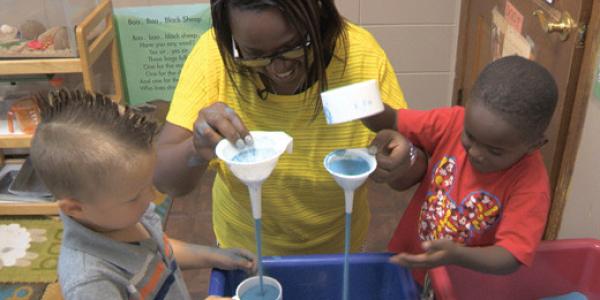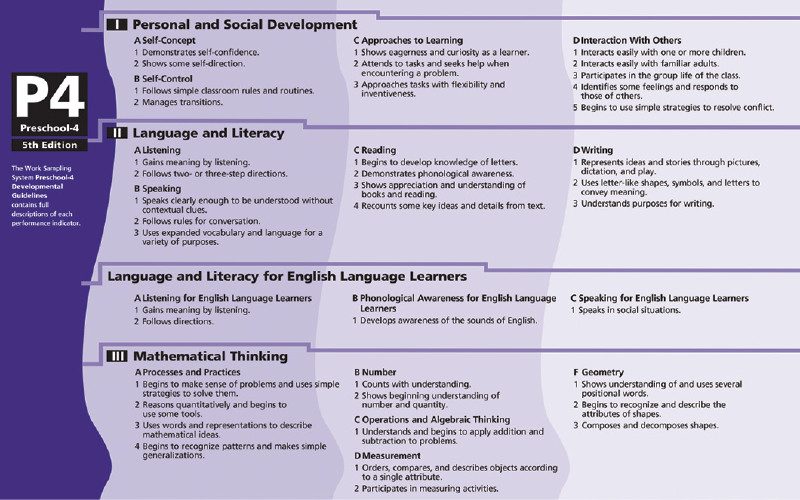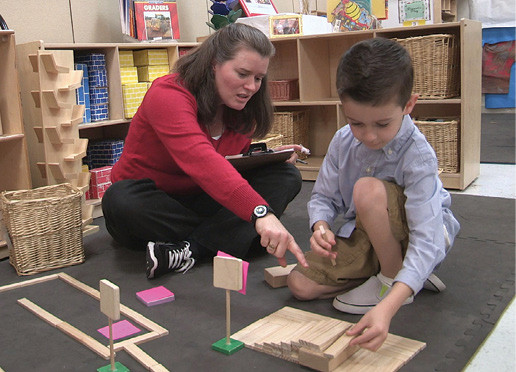Deepening Families’ Understanding of Children’s Learning in Centers

You are here
“When I drop my child off, I see some of her friends building block towers in one area of the classroom and playing grocery store in another. What’s the purpose of having different centers? And how do children learn if they play so much?” Many parents have questions like these, so we developed a family night event at our program to answer them. We invited parents and caregivers to participate in center activities to help them understand how play-based centers promote their children’s learning. We also followed up with families after the event and offered reinforcement materials. Our objective: to invite families to be partners in their children’s learning. Here’s how we did it.
Learning center observations
Laughter and conversation erupt as children and their families discuss structures in the block center, recipes in the dramatic play area, and sand flowing in the exploration station (sand and water table center). Playing beside the children, family members observe activities and write down children’s words and actions. Each center has a Work Sampling chart that lists brief summaries of the developmental guidelines—that is, performance indicators or expectations—for what children should be able to do in different curriculum areas (personal and social development, language and literacy, mathematical thinking, etc.). This helps parents and teachers identify what children are learning. From time to time, adults compare what they observe in the centers to the guidelines on the chart.
After a while, a timer goes off, signaling cleanup time. The children continue to play while the adults go to a meeting room where the program director invites family members to share their observations. She leads a discussion using The Work Sampling System performance indicators and the “Recording and Understanding Children’s Learning” handout to identify the skills the children demonstrated. There are samples below that you could use to create your own handouts specific to your program.
This scenario from a family night first took place several years ago. The event continues today in Faye’s preschool program in Camden, Arkansas. It began when Faye and her staff responded to parents’ questions about the value of children’s play and concerns about their school readiness.
Faye talked directly with parents to hear their perspectives and found that they didn’t understand what kind of learning was happening as their children played. Faye recalls, “Prior to our event, parents commented that when they asked their children what they did at school that day, the children would say ‘Nothing’ or ‘Play.’ I knew the children were learning so much through play, and I wanted their parents to know, too! If families understand all that occurs in center activities and play, they will be able to support their children’s learning during play activities at home—to be learning partners with their children.”
Faye and her staff designed the learning center family night to give parents a chance to observe and take part in their children’s play-based learning. They hoped it would create a common language about learning between home and school and strengthen families’ confidence when extending learning at home.

The Work Sampling System, Fifth Edition, Preschool-4. Copyright © 2013 NCS Pearson, Inc. Reproduced with permission. All rights reserved. “Work Sampling system” is a trademark, in the US and/or other countries, of Pearson Education, Inc. or its affiliates(s).
Learning center family night
At 6:00 p.m., the classrooms are ready. Anticipating a large turnout of families and children, each room’s seven centers are organized and inviting. As families enter their children’s classrooms, teachers greet them and give out pencils and handouts on clipboards. One handout lists behaviors to look for in different areas of development as they observe children playing and doing activities. The other gives instructions and a table to record observations.
Learning centers: Blocks, art, dramatic play, exploration station (sand and water table), math manipulatives, writing center, and classroom library.
Handout 1. Work Sampling chart (see above): Handouts of the charts posted in each of the centers, listing performance indicators, or expectations, for what children should be able to do in different curriculum areas (personal and social development, language and literacy, mathematical thinking, etc.).
Handout 2. Recording and Understanding Children’s Learning (see below): The handout tells parents, “Observe your child working and playing. What do you notice your child doing? What materials is your child using? What do you hear your child saying? Jot down what you observe.” It offers a table for recording observations by center and indicator.
Teachers move around the classroom while families and children work and play. They encourage parents to compare the notes they are taking to the charts. Teachers share examples with parents to help them get the hang of matching children’s actions with specific performance indicators. In dramatic play, 4-year-old Samantha picks up a baby doll from the crib. She says to the friend she’s playing with, “Brian, she’s hungry. Put her in the high chair and feed her.” Brian places the doll in a chair and offers it toy grapes. Looking at the list of expectations under the section Language and Literacy on the chart, Brian’s dad connects his observation of Brian’s play to the performance indicator about following two-step directions and, under Personal and Social Development, interacting easily with one or more children.
Families’ observations
Block center. Taylor works on a structure he began earlier that day. He and his teacher had labeled the building “Children’s Museum.” Taylor’s mom asks about the sign, and Taylor explains, “Ms. Jeanne and I made that sign this morning. It says Children’s Museum. We took a trip there, remember?” As Taylor continues to build, his mom asks, “What are you making now?” Taylor replies, “The staircase. Remember when we saw it?” Taylor’s mom writes, Taylor’s making a staircase for the Children’s Museum. She double-checks her Work Sampling chart, skimming the Language and Literacy section, and adds notes to Handout 2:
- Using expanded vocabulary—staircase and children’s museum
- Representing ideas through play—making a staircase with blocks
- Understands purposes for writing—asked his teacher to help make a sign

Exploration station (sand and water table). Darius’s mom joins her son and his friend as they pour sand through funnels. She writes down, Using funnels to transfer sand. The boys talk about how fast the sand flows. They count their scoops. She compares her notes to the Work Sampling chart. She sees that, along with science skills, Darius uses language and literacy and math skills while playing:
- Speaking clearly
- Using vocabulary
- Counting
- Exploring how objects and materials move
Debriefing
After 30 minutes of play and observation, it’s time to debrief. Faye and the staff know the importance of giving parents time to come together to discuss their observations, share “aha” moments, and ask questions. Parents refer to the handouts as they describe the connections they made between their observations and children’s learning. They have lively discussions and compare notes and findings; more laughter is heard. Faye and the staff encourage families to notice that children’s learning in each center addresses many different subject areas. Later that week, the handouts and examples from the discussion are shared with families through the program newsletter.
Conclusion
For several months after this year’s family night, we continued to receive positive feedback from families about their experiences with learning center observations. Faye periodically sends out a form asking families to share anecdotal notes from conversations with their children about their play experiences at home. She notices that parents are having more in-depth conversations with their children and are beginning to understand and appreciate the learning that occurs through play. Families have become true learning partners with the preschool staff and with their children.
Sample Handout 2: Recording and Understanding Children's Learning
| In the _____ center ... | We observed children (doing, using, saying) ... | Children are learning to … |
| Block |
|
|
| Exploration station (sand and water) |
|
|
| Exploration station (sand and water) |
|
|
| Dramatic play |
|
|
| Art |
|
|
The performance indicators in the third column are adapted from The Work Sampling System: Preschool–4 Developmental Guidelines. Copyright © 2013 NCS Pearson, Inc. All rights reserved. Portions of this work were published in previous editions.
Sample Anecdotal Note From a Parent

At our house, I’ve gathered materials and created a space where Jaycee can make art. I started displaying her pictures and writing down what she says about them. I’m looking around for more materials, like recycled paper, ribbons, and packaging, that Jaycee can use in her artwork.
Photos courtesy of Shaun Johnsen
Faye Dismuke is the lead teacher and education coordinator of the early childhood program at Ouachita Child Enrichment Centers/ABC Program, in Camden, Arkansas.
Nichole Parks is a program coordinator with Arkansas State University Childhood Services, in Jonesboro, Arkansas.
Judy Jablon is executive director of Leading for Children, a nonprofit organization focused on leadership in early learning, and author of numerous publications about early education.